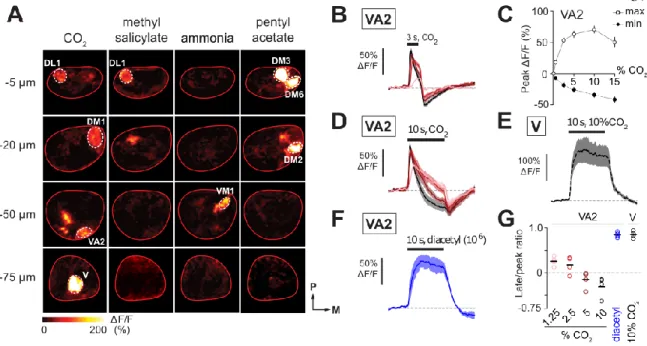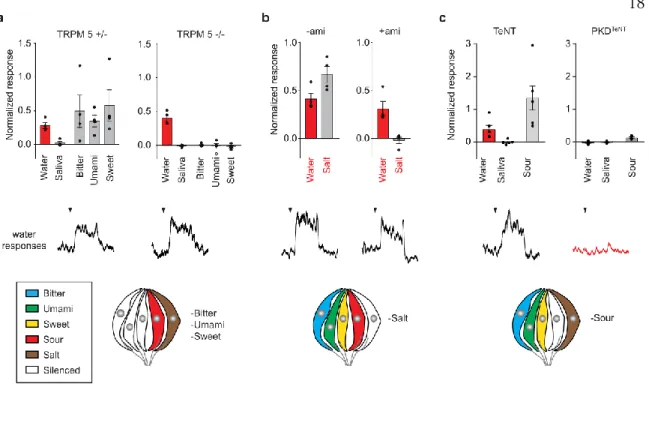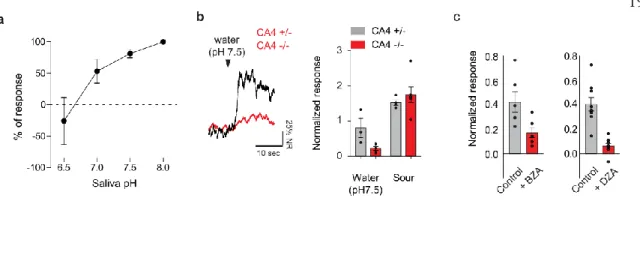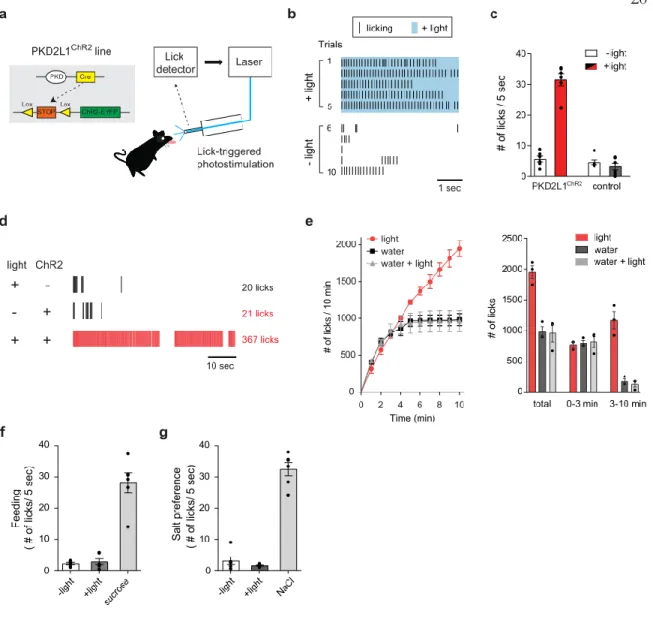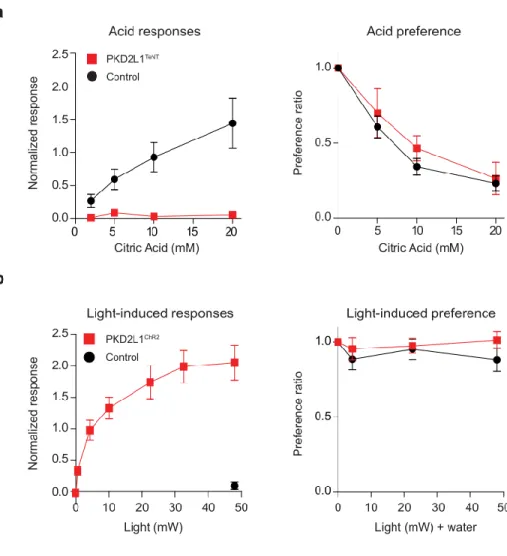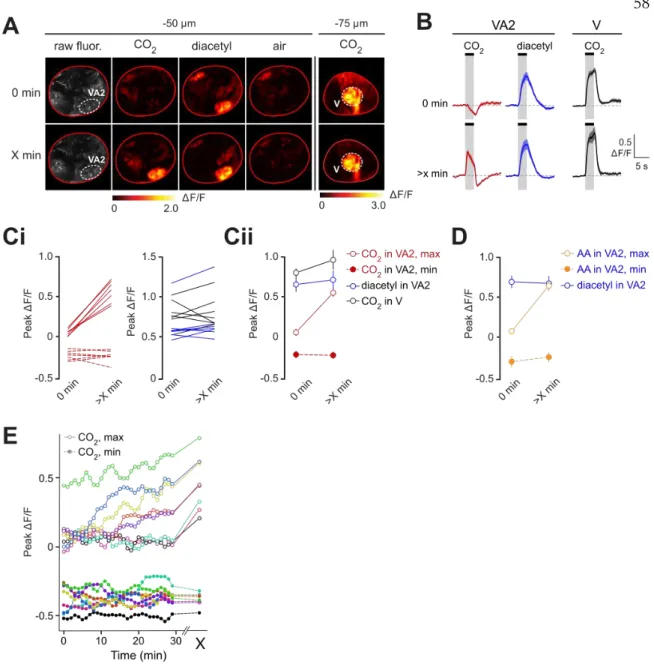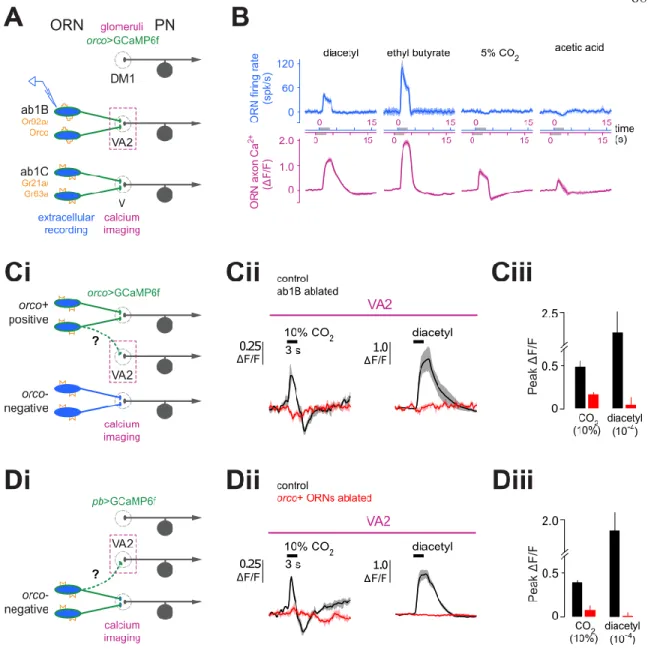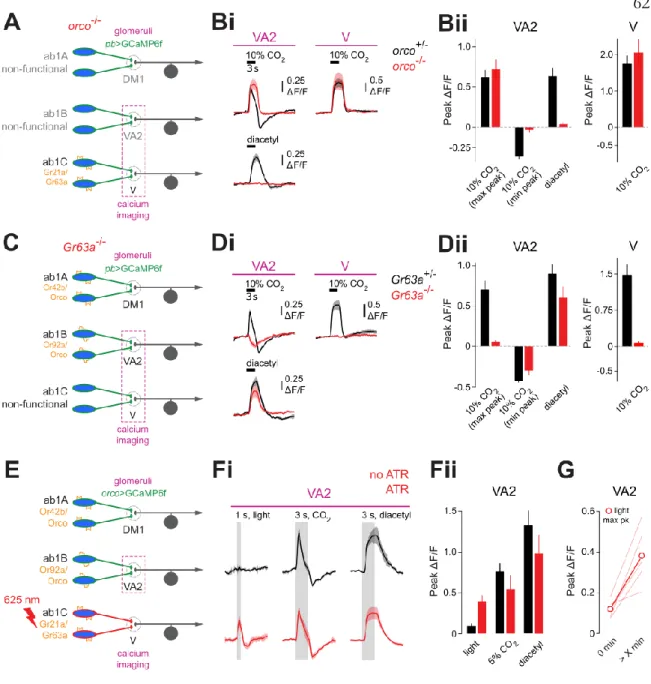Furthermore, optogenetic stimulation of the acid-sensing TRCs in thirsty animals induces robust licking responses toward the light source, even in the absence of water. The cellular mechanism of water detection in the mammalian gustatory system." In: Nature Neuroscience 20, pp.
THE DETECTION OF WATER BY THE MAMMALIAN TASTE SYSTEM
SUMMARY
INTRODUCTION
WATER ELICITS RESPONSES FROM THE TASTE SYSTEM
Therefore, we had to continuously perfuse into the oral cavity an artificial saliva solution consisting of the ionic components of normal saliva. The water responses we measured were therefore the result of washing out the ions present in saliva with pure deionized water.
ACID SENSING TRCS ARE RESPONSIBLE FOR WATER RESPONSES
If the observed responses are the basis of water detection, one would expect the responses to be selective for aqueous solutions. Altogether, these results demonstrate that the acid-sensitive taste pathway is the cellular substrate for chorda tympani responses to water.
CARBONIC ANHYDRASES FUNCTION AS MOLECULAR DETECTORS FOR WATER
Surprisingly, disruption of synaptic transmission from acid-sensitive TRCs resulted in a total loss of water responses (Figure 2c) without affecting other taste qualities, with the exception of acid responses (Extended Data Figure 2b). These results suggest that CA4, and perhaps other CAs, function as molecular detectors that translate water stimuli into a local pH drop (Extended Data Figure 3c).
OPTOGENETIC ACTIVATION OF SOUR SENSING TRCS DRIVES APPETTITIVE LICKING RESPONSES IN THIRSTY
We next asked whether long-term activation of acid-sensitive TRCs could lead to satiation of thirst. Together, these results clearly demonstrate that activation of acid-sensitive TRCs serves as a cue for the presence of water, but does not serve as a satiety signal by itself.
SILENCING ACID SENSING TRCS AFFECTS FLUID DISCRIMINATORY ABILITY IN THIRSTY MICE
SILENCING ACID SENSING TRCS DOES NOT AFFECT AVERSION TO SOUR TASTANTS
To resolve this apparent conflict, we investigated whether PKD2L1-expressing TRCs are required for behavioral aversion to sour tastants. These data show that the taste pathway is not necessary for behavioral aversion to acids.
DISCUSSION
On the other hand, optogenetic stimulation of the same population with ChR2 (PKD2L1ChR2 animals) induced a dose-dependent robust activation of the gustatory nerve (Figure 5b, left panel). Notably, behavioral attraction was induced by photostimulation of the water taste pathway only when the animals were dehydrated, but not without food or salt. Briefly, the animals were tracheotomies to prevent suffocation and the right branch of the chorda tympani nerve was exposed.
Representative integrated chorda tympani nerve responses to water and five basic tastes (top) and their quantified data (bottom) are shown. Removal of bicarbonate ions elicits a water response, whereas saliva without bicarbonate ions or other types of ions had no effect (n=3 for saliva, n=4 for other solutions; p=0.0286, . KHCO3 vs saliva - HCO3). Higher concentrations of potassium bicarbonate elicited greater water responses, whereas potassium chloride elicited no response (n=4).
Shown are representative traces to water and silicone oil (left), and quantification of responses is shown (right, n=4; .p=0.0286). The data demonstrate that the acid-sensing taste pathway is required for taste responses to water. Photostimulation of the tongue induces robust drinking (trials 1–5: blue shading) after ablation of ChR2-positive geniculate neurons.
Response rise time (n=7, p=0.0157, middle), and ratio of the rising slopes (right) show slower kinetics of water responses compared to citric acid.
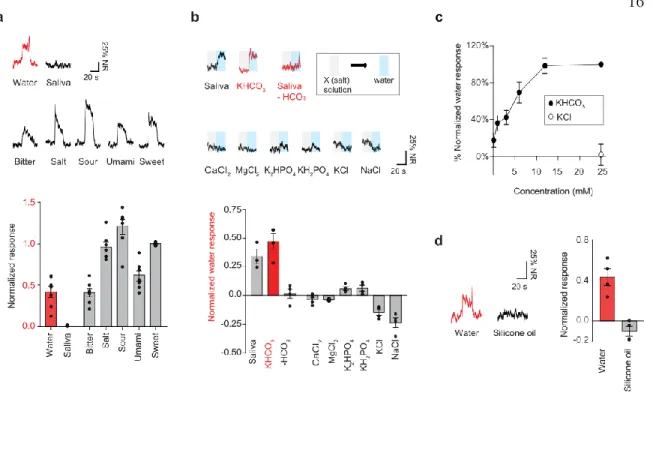
Amiloride-sensitive NaCl taste responses are associated with genetic variation of ENaC alpha subunit in mice. Effects of various ion transport inhibitors on the water response in the superior laryngeal nerve in rats.
LATERAL FLOW OF INFORMATION AT PRIMARY OLFACTORY AFFERENTS
The first layer of the drosophila olfactory pathway consists of 50 distinct classes of olfactory receptor neurons (ORNs), defined by their expression of 1 of 50 different olfactory receptors (ORs). structures called sensilla covering the 2 antennae.4 Each sensillum contains 2-4 individual ORNs of different classes. From the antenna, ORNs project their axons via the Antennal Nerve to the Antennal Lobes (AL) of the brain. Thus, there are 50 glomeruli for the 50 ORN classes, defining 50 olfactory coding channels.5,6 A typical odor binds with some affinity to a subset of ORNs, and thus triggers activity in multiple glomeruli.
Most odors are thus represented by a combinatorial code in AL.7. Some specialized odors only stimulate activity in individual outermost regions and are instead coded in the simpler way of labeled lines. These take the form of inhibition of forward transmission of ORN terminals19,20,21 as well as local ephaptic effects occurring on cell bodies.22 Therefore, at the first layer of the olfactory pathway, excitatory responses in the 50 coding channels are assumed to be completely independent of each other. . We then show that the CO2 responses measured in Ab1B axon terminals do not occur in the corresponding cell bodies.
Instead, the excitatory component of the responses comes laterally from the Ab1C ORNs and completely bypasses the Ab1B cell bodies. The inhibitory component of the responses depends on Orco and probably comes laterally as well.
MULTIPLE ORN CLASSES RESPOND TO CO 2
Given the very narrow OR activation profile, we use CO2 as a diagnostic odor for responses arising in ORN terminals via lateral interactions. By focusing on one of these glomeruli, VA2, which receives input from Ab1B ORNs, we show that the CO2 responses change from a low state, characterized by a purely inhibitory response, to a high state, characterized by a strong excitation followed by a lagging inhibition. . This response switch is not unique to CO2, as we show that the same behavior occurs in Ab1B terminals in response to acetic acid.
Finally, we show that the presence of lateral input generalizes to the DM1 glomerulus, which receives input from Ab1A ORNs. Here we show that multiple odorants are delivered laterally to Ab1A ORN terminals, again bypassing Ab1A cell bodies. We thus identify a network of excitatory interactions that enable the lateral flow of olfactory information between ORN terminals.
The responses had unusual transient dynamics consisting of a fast excitatory component followed by a slower inhibitory period. For 10-second CO2 pulses, the VA2 responses were dominated by an inhibitory component, leading to severely attenuated excitatory responses.
Taken together, these results indicate that CO2, a particularly narrowly activating odorant measured at the ORN cell body, activates multiple ORN axon terminals. We found that there is no characteristic time course for the switch: some flies switch within minutes, others take as long as 30 minutes, and still others take over an hour (Fig. 2e). We next confirmed whether the other newly identified CO2-responsive glomeruli also show a switching behavior.
Finally, we examined whether other odors elicit a similar switching behavior in VA2. Furthermore, this switch is not specific to CO2, but also occurs for certain short-chain fatty acids in VA2 ORNs (acetic acid and several other related compounds for which no data are shown).
MISMATCH IN ODOR TUNING BETWEEN VA2 ORN SOMA AND AXON TERMINALS
Again, VA2 was completely silent (Fig3dii,iii), indicating that the CO2 responses we measured in VA2 do not originate from Orco-negative ORN terminals entering VA2. Together, these results show that the CO2 responses measured in VA2 do not originate from foreign terminals entering VA2, but represent signals located in Ab1B axon terminals. Importantly, responses in Ab1B to diacetyl, known to directly drive the Ab1B OR (Fig. 3b), were abolished in this line, confirming that the Ab1B OR was effectively silenced (Fig. 4bi,ii) .
In summary, the data above show that the CO2 responses measured in VA2 ORN terminals do not originate from Ab1B's endogenous OR, suggesting instead the presence of lateral excitatory inputs on VA2 axon terminals. The fact that excitatory CO2 responses persist in Or83b2 also suggests that the actual source of the responses is Orco-negative. Surprisingly, excitatory CO2 responses in Ab1B ORNs were abolished in the mutant, while diacetyl responses remained (Fig. 4di, ii).
CO2 responses in Ab1C were also gone, confirming that Ab1C ORNs had been effectively silenced. Furthermore, the light-driven responses mirrored the CO2 responses in that they turned on during the recordings (Fig. 4g).
DM1 ORNS ALSO RECEIVE LATERAL INPUTS
We imaged Ab1B axon terminal calcium responses while directly stimulating the antenna with red light. Responses consisted of a short excitatory phase without inhibitory components, reconfirming that the inhibition seen with CO2 stimuli does not originate from Ab1C. This suggests that the remaining terminal responses (Fig. 5d) are the result of lateral inputs from other Orco-positive ORNs to Ab1A terminals.
Finally, we addressed the possibility that we may have misidentified DM1 in the imaging experiments. To confirm the correct identification of DM1, we expressed Dtx in Or42b positive ORNs while expressing GCaMP in all ORNs. DM1 was conspicuously absent from baseline fluorescence in these flies, and all Ab1A axon-end odor responses were absent (Extended Data Figure 3).
Together, these results suggest that the majority of odorants that activate DM1 arise from direct activation of Ab1A cell bodies as well as indirect, collateral excitatory inputs from other classes of ORNs, most of which are Orco-positive. Thus, lateral excitatory inputs appear to be a general feature of ORNs in the AL circuit.
MIXED EXCITATION AND INHIBITION CONFERS SPECIAL RESPONSE PROPERTIES ON ORN AXONS
In the case of another study, attractiveness appears to be related to year. We found that CO2 elicits responses in Ab1B axon terminals but not in the corresponding cell bodies. For heatmaps, dF/F was calculated for each pixel in the image at the peak of the odor response (average of 3 frames centered at the peak of the response).
It was this work that led us to look at CO2 responses in the antennal lobe. Top row shows responses measured at the start of the experiment, bottom row shows responses in the same plane at the end of the experiment. Note the complete absence of responses in the cell body and the remaining responses in the axon terminals (n=3 electrophysiology, n=6-13 imaging).
SSR and calcium imaging in Ab1A and DM1, with GCaMP6f expressed under Pb-Gal4 control in the Orco mutant background. Note the collapse of all wind responses in both cell body and terminals except for CO2 responses in axon terminals (n=3 electrophysiology, n=3–5 images). Activation of accessory glomeruli in response to ethyl acetate and diacetyl in homozygous knockouts.
The remaining responses in the silenced Or42b line do not come from out-of-plane fluorescence.
